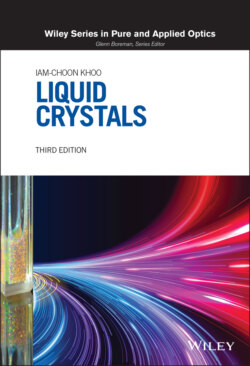Читать книгу Liquid Crystals - Iam-Choon Khoo - Страница 14
1.2.2. Visible and Infrared Absorption; Terahertz, Microwave
ОглавлениеThe spectral transmission dependence of two typical liquid crystals is shown in Figure 1.7a and b. Liquid crystals are quite absorptive in the UV region, as are most organic molecules/liquids. In the visible and near‐infrared (IR) regime (i.e. from 0.4 to ~2 μm), there are no absorption bands, and thus liquid crystals are quite transparent in this regime. In the mid‐IR (3–5 μm) and IR (9–12 μm), rovibrational transitions begin to dominate, and liquid crystals are quite absorptive in this spectral area (Table 1.1).
Table 1.1 Anisotropic Physical Parameters of a Typical Nematic Liquid Crystals (E7)
| n // | n ⊥ | Δn | α// (cm−1) | α⊥ (cm−1) | |
|---|---|---|---|---|---|
| 1.75 | 1.525 | 0225 | … | … | (λ = 0.589 μm) |
| 1.71 | 1.50 | 0.21 | … | … | (λ = 1.55 μm) |
| 1.70 | 1.49 | 0.21 | 55 | 40 | (λ = 10.59 μm) |
| 1.73 | 1.57 | 0.9 | 3.1 | (0.2 THz) | |
| 1.76 | 1.62 | 7 | 27 | (2 THz) | |
| Thermal diffusion constant: | |||||
| Elastic constants: | |||||
| Viscosity coefficients: (at 20 °C) |
Figure 1.7. Transmission spectra of nematic liquid crystals: (a) 5CB; (b) N‐(4‐methoxybenzylidene)‐4‐butylaniline (MBBA).
The absorption coefficient α in the UV (~0.2 μm) regime is on the order of 103 cm−1; in the visible (~0.5 μm) regime, α ≪100 cm−1; in the near‐IR (~3–5 μm and ~9–12 μm) regime, α ~ 102 cm−1. There are, of course, large variations among the thousands of liquid crystals that have been synthesized. It is possible to identify liquid crystals with the desirable absorption/transparency for a wavelength of interest. For example, the terahertz and microwave regime, [5, 6] have identified/synthesized liquid crystals (LC’s) with relatively low absorption coefficient α ~ 100 cm−1; low absorption is important since applications in such long‐wavelength regimes require much thicker interaction length (cell thickness).
A unique advantage of liquid crystals is the sizeable birefringence throughout the entire visible–IR‐terahertz‐microwave spectrum. At the 20–60 GHz region, [6] has shown that for a typical liquid crystal such as E7, εe = 3.17 (refractive index ne = 1.78) and ε0 = 2.72 (refractive index n0 = 1.65), i.e. a birefringence Δn ~ 0.13.
